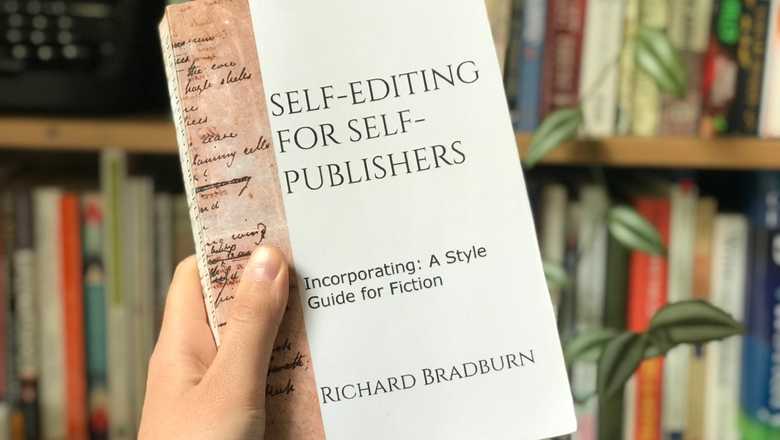Self-Editing for Self-Publishers – Incorporating: A Style Guide for Fiction by Richard Bradburn is an immensely generous book. It’s a chunky tome that covers a huge amount of ground.
It teaches self-publishing novelist how to do what professional editors would do to their manuscript.
For self-publishing authors on a budget, spending the time and effort to learn and apply these editing techniques would give them the best advantage possible without having to spend out on professional editing.
So … can it replace professional editing?
Bradburn is, however, a professional editor (as well as a writer), and as such he understands the value professional editors bring to the table.
He makes an excellent case as to why the best method for self-publishing authors would be to take their manuscript as far as they can on their own, then hire a professional – in short, your money will go further and you’ll end up with a better book.
And as you read through the 400-ish pages of Self-Editing for Self-Publishers, I think any author would quickly realise the amount of specialist skill and knowledge an editor has, and that reading a single book on the subject is no substitute for years of training and experience – not to mention that if you edit your own novel, you’ll never be able to do so with a fully objective eye.
What does Self-Editing for Self-Publishers cover?
The book is divided into three parts.
- Part 1 discusses the concept of self-editing.
- Part 2 looks at how to developmentally edit your novel (making sure the big-picture aspects – like story, character, point of view, etc.) are all working as effectively as possible.
- Part 3 then looks at sentence-level editing (what’s known as copy-editing in the industry), and it’s this section that forms the ‘style guide’ referenced in the book’s title.
There’s also a generous number of appendixes that cover synopsis writing, hiring an editor, editing terminology, using beta readers, and the pitfalls of editing software – as well as a more in-depth look at point of view.
At first, I wondered whether this book would be better as two books – the first covering the developmental editing stage and the second covering the line editing stage – but the fact this book covers both aspects makes it uniquely comprehensive, and it emphasises how you really need to do both stages of editing.
On the less positive side, I did find that some of the examples used to illustrate the techniques discussed in the book weren’t as illustrative as they perhaps could have been, and some of them contained some slightly questionable content and potentially triggering references to abuse.
Occasionally, I disagreed with some of the content – or I found it wasn’t presented as clearly as it could have been. For example, I think there were some nuances of tense and point of view that weren’t addressed (with a few things that didn’t seem quite right to me, either).
The overall advice around point of view was good, but it could have been better, and so I would recommend supplementing this book with another if you wanted to really get to grips with viewpoint. The Power of Point of View by Alicia Rasley is an excellent resource.
The overwhelming majority of the content was excellent, though.
What’s the difference between revising and self-editing, and is this important?
To me, self-editing at the sentence level seems much easier to define than self-editing at the story level. To edit a sentence means to look at the punctuation, grammar, spelling and structure.
But what’s the difference between revising a manuscript and self-editing it for story, character, point of view, etc?
Bradburn makes the distinction by saying that when an author revises or redrafts their manuscript, they’re still in a creative mindset. They’re still building the novel – filling in missing parts and taking away bits that have ended up irrelevant.
When professional editors work on a manuscript at this macro level, they look at refining what is already there, specifically to shape it into something they predict readers will enjoy so that it sells.
I’m not entirely sure I agree with this definition because some developmental editors (like myself) will also try to help the author reach their personal creative vision for their book, and the process of developmental editing is more than cutting and shaping what’s already in existence; sometimes it requires asking authors to do some further creation, to fill in missing parts or strengthen or change certain aspects.
I’m not sure how important this distinction between revising and self-editing at the macro level is, but perhaps it’s more of a mindset switch from the author thinking about refining their creative vision to moulding the manuscript to better appeal to its intended readership.
In this way, Part 1 of Self-Editing for Self-Publishers could serve an author both with their revisions and their developmental editing – the boundary between which is quite hazy, in my view, if you’re doing both things yourself.
That’s not a criticism of the book, though. More a point to ponder.
Does the book work as a style guide for fiction?
The book’s subtitle is Incorporating: A Style Guide for Fiction, and this is something I was keen access as most of the style guides professionals in publishing use for reference are geared more towards non-fiction.
However, the style guide section takes up only a quarter of the book (Part 3). As well as that, the section contains more explanation and teaching than I would expect from something trying to be a source of reference.
That’s not wholly a bad thing – the advice is very good – but if you wanted to quickly look something up (which is often how style guides are used), you’d sometimes have to search through more conversational paragraphs of context to find what you need.
The book doesn’t quite work as a source of reference you could dip in and out of because sometimes important caveats are mentioned in other parts of the book, or aspects are built upon.
This is the challenge of working with something as subjective, flexible and complicated as fiction – it’s sometimes very hard to set down definitive guiding principles. As Bradburn himself writes: ‘In fiction, if something works, then it works.’
Lastly, though style sheets are explained in the book (a style sheet is a reference a professional editor creates for your manuscript where they take note of textual stylistic decisions), it would have been really handy to see a few completed examples and to have been provided with a template.
Who would I recommend this book to, and how should they use it?
The fact this book covers so much ground works both for and against it.
For some authors, it would be overwhelming. Some authors might not want to put so much time and effort into the self-editing stage of the publication process. In which case, this book is not for them!
However, if you’re the kind of author who is adamant that they want to publish their best work, I would highly recommend this book. In an ideal world, you’d also hire a professional editor to address your inevitable blind spots, but if budget is an issue (and it is for many, many writers) Self-Editing for Self-Publishers is an invaluable resource.
It demystifies the process of professional-level editing and provides an incredibly helpful framework and roadmap for authors to follow.
Instead of thinking of this book as a style guide for fiction, I recommend reading it straight through and then working through it step-by-step. Bradburn provides handy guidance at the end of each section so you can easily see how to put the theory into practice.
I would also recommend this book to any professional editor who works with fiction as it provides such an excellent overview of how a manuscript should be treated during the publication process, as well as giving the editor a wider understanding of the author’s role in shaping their work.





